Compressive Sensing-Based Channel Estimation for Uplink and Downlink Reconfigurable Intelligent Surface-Aided Millimeter Wave Massive MIMO Systems
Abstract
:1. Introduction
- To apply the techniques of compressive sensing for CSI estimation, the channel sparsity formulations are presented for both the downlink and uplink channels of the RIS-supported mmWave massive MIMO multicarrier systems. Through these formulations, the channel estimations in these two scenarios are turned into sparse signal recovery problems.
- To estimate the uplink user-to-RIS channel of the RIS-aided mmWave massive MIMO multicarrier systems, two CS-based algorithms channel estimation techniques are formulated. These are based on adaptive SOMP and structured matching pursuit (StrMP) algorithms, and the estimators are named AdptSOMP-based channel estimation and StrMP-based channel estimation schemes for the uplink channel.
- Similarly, to estimate the downlink BS-to-user and RIS-to-user channels of the two-user RIS-aided mmWave massive MIMO multicarrier systems, the above-mentioned channel estimation schemes in (ii) are redesigned for this purpose.
- To have an idea of the incurred costs in terms of computational complexities that are involved in computing the proposed channel estimation schemes, the comparative complexity analysis costs of the proposed schemes and two benchmark schemes considered in this paper are documented.
2. System Models for RIS-Aided mmWave Massive MIMO Systems
2.1. Uplink RIS-Aided mmWave Massive Mimo System Model
2.2. Uplink RIS-UE Channel Sparsity Formulation
2.3. Downlink RIS-Aided mmWave Massive Mimo System Model
2.4. RIS-Supported Downlink Sparsity Formulation
3. The Compressive Sensing-Based Channel Estimation Schemes
3.1. Adaptive SOMP(AdptSOMP)-Based Channel Estimation Scheme for the Uplink Channel
| Algorithm 1 The AdptSOMP-based Channel Estimation Scheme for Uplink RIS-Aided mmWave Massive MIMO System |
| Input: Observation measurements sensing matrices , the power threshold for determining the active paths [11], number of multipath components , redundant dictionary , and the stopping criterion threshold . Output: Reconstructed sparse channel Initialization:
for do
where stands for the number of nonzero elements in . The estimation of the sparsity level update is based on the knowledge that the input to the AdptSOMP can vary with varying channel conditions, which, in turn, could alter the sparsity level. Thus, AdptSOMP is adaptive to the channel sparsity level . In addition, AdptSOMP roughly considers the temporal correlations of the dynamic sparse channel.
|
3.2. Adaptive SOMP(AdptSOMP)-Based Channel Estimation Scheme for the Downlink Channel
| Algorithm 2 The AdptSOMP-based Channel Estimation Scheme for Downlink RIS-Aided mmWave Massive MIMO System |
| Input: Observation measurements , the measurements matrix ,the effective dictionary matrix , , the power threshold for determining the active paths [25], the number of multipath components , redundant matrices and , and the stopping criterion threshold . Output: Estimated channel vectors and . Initialization: Iteration counter Residual error vector at iteration Support set at the iteration Iteration:
|
3.3. Structured Matching Pursuit (StrMP)-Based Channel Estimation Scheme for the Uplink Channel
| Algorithm 3 The StrMP-based Channel Estimation Scheme for Uplink RIS-Aided mmWave Massive MIMO System |
| Input: The Observation measurements , the sensing matrices , , redundant dictionary , the stopping criterion threshold , and the maximum sparsity level possible . Output: Reconstructed sparse channel Stage A: Computation of the Initial Support Set
|
3.4. Structured Matching Pursuit (StrMP)-Based Channel Estimation Scheme for the Downlink Channel
| Algorithm 4 The StrMP-based Channel Estimation Scheme for Downlink RIS-Aided mmWave Massive MIMO System |
| Input: Observation measurements , the measurements matrix , the effective dictionary matrix , , the number of multipath components , redundant matrices and , maximum sparsity level , and the stopping criterion threshold . Output: Estimated channel vectors and . Stage 1: Initial support set estimation Initialization: Residual error vector Support set at the iteration Iteration: for do
Stage 2: Estimation of the temporal sparse signal Initialization: Iteration counter Initial estimation of the sparse signals Residual error vector at the iteration Support set at the iteration while do
Stage 3: Decomposition and Computation of the final CSI
|
3.5. Comparative Computational Complexity Costs of the Proposed Estimator
4. Simulation Results and Discussion
4.1. Simulation Results for the Uplink RIS-Aided mmWave Massive Mimo System Model
4.2. Simulation Results for the Downlink RIS-Aided mmWave Massive MIMO System Model
5. Conclusions
Author Contributions
Funding
Data Availability Statement
Conflicts of Interest
References
- Dai, L.; Wang, B.; Wang, M.; Yang, X.; Tan, J.; Bi, S.; Xu, S.; Yang, F.; Chen, Z.; Renzo, M.D.; et al. Reconfigurable Intelligent Surface-Based Wireless Communications: Antenna Design, Prototyping, and Experimental Results. IEEE Access 2020, 8, 45913–45923. [Google Scholar] [CrossRef]
- Wu, Q.; Zhang, R. Intelligent Reflecting Surface Enhanced Wireless Network via Joint Active and Passive Beamforming. IEEE Trans. Wireless Commun. 2019, 18, 5394–5409. [Google Scholar] [CrossRef]
- Zheng, B.; You, C.; Mei, W.; Zhang, R. A Survey on Channel Estimation and Practical Passive Beamforming Design for Intelligent Reflecting Surface Aided Wireless Communications. IEEE Commun. Surv. Tutorials 2022, 24, 1035–1071. [Google Scholar] [CrossRef]
- Basar, E.; Di Renzo, M.; De Rosny, J.; Debbah, M.; Alouini, M.-S.; Zhang, R. Wireless Communications Through Reconfigurable Intelligent Surfaces. IEEE Access 2019, 7, 116753–116773. [Google Scholar] [CrossRef]
- Huang, C.; Zappone, A.; Alexandropoulos, G.C.; Debbah, M.; Yuen, C. Reconfigurable Intelligent Surfaces for Energy Efficiency in Wireless Communication. IEEE Trans. Wireless Commun. 2019, 18, 4157–4170. [Google Scholar] [CrossRef]
- Mishra, D.; Johansson, H. Channel Estimation and Low-Complexity Beamforming Design for Passive Intelligent Surface Assisted MISO Wireless Energy Transfer. In Proceedings of the ICASSP 2019—2019 IEEE International Conference on Acoustics, Speech and Signal Processing (ICASSP), Brighton, UK, 12–17 May 2019; pp. 4659–4663. [Google Scholar]
- Yashvanth, L.; Murthy, C.R. Cascaded Channel Estimation for Distributed IRS Aided mmWave Massive MIMO Systems. In Proceedings of the GLOBECOM 2022—2022 IEEE Global Communications Conference, Rio de Janeiro, Brazil, 4 December 2022; pp. 717–723. [Google Scholar]
- Oyerinde, O.O.; Flizikowski, A.; Marciniak, T. Remodelled and Reduced Complexity-OMP-Based Channel Estimation Schemes for Intelligent Reflecting Surface-Aided Millimeter Wave Systems. In Proceedings of the 2023 16th International Conference on Signal Processing and Communication System (ICSPCS), Bydgoszcz, Poland, 6 September 2023; pp. 1–5. [Google Scholar]
- Oyerinde, O.O.; Flizikowski, A.; Marciniak, T. Iterative Hybrid Compressive Sensing-Based Channel Estimation Method for Intelligent Reflecting Surface-Supported Millimeter Wave Systems. AEU-Int. J. Electron. Commun. 2023, 184, 155415. [Google Scholar] [CrossRef]
- He, Z.-Q.; Yuan, X. Cascaded Channel Estimation for Large Intelligent Metasurface Assisted Massive MIMO. IEEE Wireless Commun. Lett. 2020, 9, 210–214. [Google Scholar] [CrossRef]
- Wang, P.; Fang, J.; Duan, H.; Li, H. Compressed Channel Estimation for Intelligent Reflecting Surface-Assisted Millimeter Wave Systems. IEEE Signal Process. Lett. 2020, 27, 905–909. [Google Scholar] [CrossRef]
- Wan, Z.; Gao, Z.; Alouini, M.-S. Broadband Channel Estimation for Intelligent Reflecting Surface Aided mmWave Massive MIMO Systems. In Proceedings of the ICC 2020—2020 IEEE International Conference on Communications (ICC), Dublin, Ireland, 7–11 June 2020; pp. 1–6. [Google Scholar]
- Liu, S.; Gao, Z.; Zhang, J.; Renzo, M.D.; Alouini, M.-S. Deep Denoising Neural Network Assisted Compressive Channel Estimation for mmWave Intelligent Reflecting Surfaces. IEEE Trans. Veh. Technol. 2020, 69, 9223–9228. [Google Scholar] [CrossRef]
- Wei, L.; Huang, C.; Alexandropoulos, G.C.; Yuen, C.; Zhang, Z.; Debbah, M. Channel Estimation for RIS-Empowered Multi-User MISO Wireless Communications. IEEE Trans. Commun. 2021, 69, 4144–4157. [Google Scholar] [CrossRef]
- Akdeniz, M.R.; Liu, Y.; Samimi, M.K.; Sun, S.; Rangan, S.; Rappaport, T.S.; Erkip, E. Millimeter Wave Channel Modeling and Cellular Capacity Evaluation. IEEE J. Select. Areas Commun. 2014, 32, 1164–1179. [Google Scholar] [CrossRef]
- Davenport, M.A.; Laska, J.N.; Treichler, J.R.; Baraniuk, R.G. The Pros and Cons of Compressive Sensing for Wideband Signal Acquisition: Noise Folding versus Dynamic Range. IEEE Trans. Signal Process. 2012, 60, 4628–4642. [Google Scholar] [CrossRef]
- Choi, J.W.; Shim, B.; Ding, Y.; Rao, B.; Kim, D.I. Compressed Sensing for Wireless Communications: Useful Tips and Tricks. IEEE Commun. Surv. Tutorials 2017, 19, 1527–1550. [Google Scholar] [CrossRef]
- Gao, Z.; Dai, L.; Wang, Z.; Chen, S. Spatially Common Sparsity Based Adaptive Channel Estimation and Feedback for FDD Massive MIMO. IEEE Trans. Signal Process. 2015, 63, 6169–6183. [Google Scholar] [CrossRef]
- Gao, Z.; Hu, C.; Dai, L.; Wang, Z. Channel Estimation for Millimeter-Wave Massive MIMO with Hybrid Precoding over Frequency-Selective Fading Channels. IEEE Commun. Lett. 2016, 20, 1259–1262. [Google Scholar] [CrossRef]
- 3GPP. Study on Channel Model for Frequency Spectrum Above 6 GHz; TR 38.900 (Rel. 14); ETSI: Sophia Antipolis, France, 2016. [Google Scholar]
- Oyerinde, O.O. Recast Subspace Pursuit-Based Channel Estimation for Hybrid Beamforming NarrowBand Millimeter-Wave Massive MIMO Systems. In Proceedings of the 2022 IEEE 95th Vehicular Technology Conference: (VTC2022-Spring), Helsinki, Finland, 19–22 June 2022; pp. 1–6. [Google Scholar]
- Liao, A.; Gao, Z.; Wang, H.; Chen, S.; Alouini, M.-S.; Yin, H. Closed-Loop Sparse Channel Estimation for Wideband Millimeter-Wave Full-Dimensional MIMO Systems. IEEE Trans. Commun. 2019, 67, 8329–8345. [Google Scholar] [CrossRef]
- Oyerinde, O.O.; Flizikowski, A.; Marciniak, T. Adjusted Orthogonal Matching Pursuit Based Channel Estimation for Hybrid Beamforming Millimeter Wave Wireless Communication Systems. In Proceedings of the 2021 15th International Conference on Signal Processing and Communication Systems (ICSPCS), Sydney, Australia, 13 December 2021; pp. 1–6. [Google Scholar]
- Oyerinde, O.O.; Flizikowski, A.; Marciniak, T. Compressive Sensing-Based Channel Estimation Schemes for Wideband Millimeter Wave Wireless Communication Systems. Comput. Electr. Eng. 2022, 104, 108452. [Google Scholar] [CrossRef]
- Dai, L.; Wang, J.; Wang, Z.; Tsiaflakis, P.; Moonen, M. Spectrum- and Energy-Efficient OFDM Based on Simultaneous Multi-Channel Reconstruction. IEEE Trans. Signal Process. 2013, 61, 6047–6059. [Google Scholar] [CrossRef]
- Wang, Y.; Tian, Z. Chunyan Feng Sparsity Order Estimation and Its Application in Compressive Spectrum Sensing for Cognitive Radios. IEEE Trans. Wireless Commun. 2012, 11, 2116–2125. [Google Scholar] [CrossRef]
- Rangan, S.; Rappaport, T.S.; Erkip, E. Millimeter-Wave Cellular Wireless Networks: Potentials and Challenges. Proc. IEEE 2014, 102, 366–385. [Google Scholar] [CrossRef]
- Zhu, X.; Dai, L.; Gui, G.; Dai, W.; Wang, Z.; Adachi, F. Structured Matching Pursuit for Reconstruction of Dynamic Sparse Channels. In Proceedings of the 2015 IEEE Global Communications Conference (GLOBECOM), San Diego, CA, USA, 6–10 December 2015; pp. 1–5. [Google Scholar]
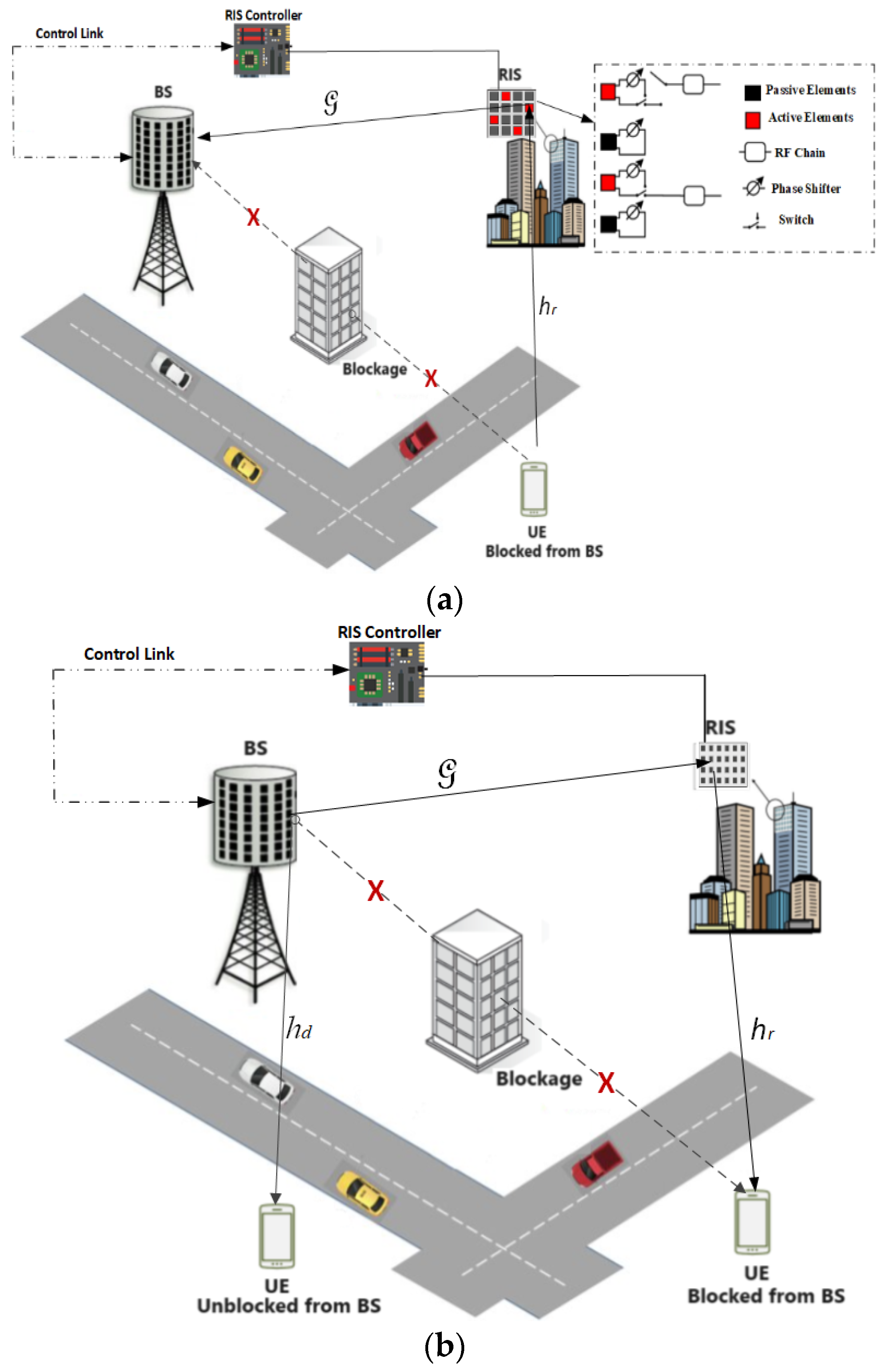
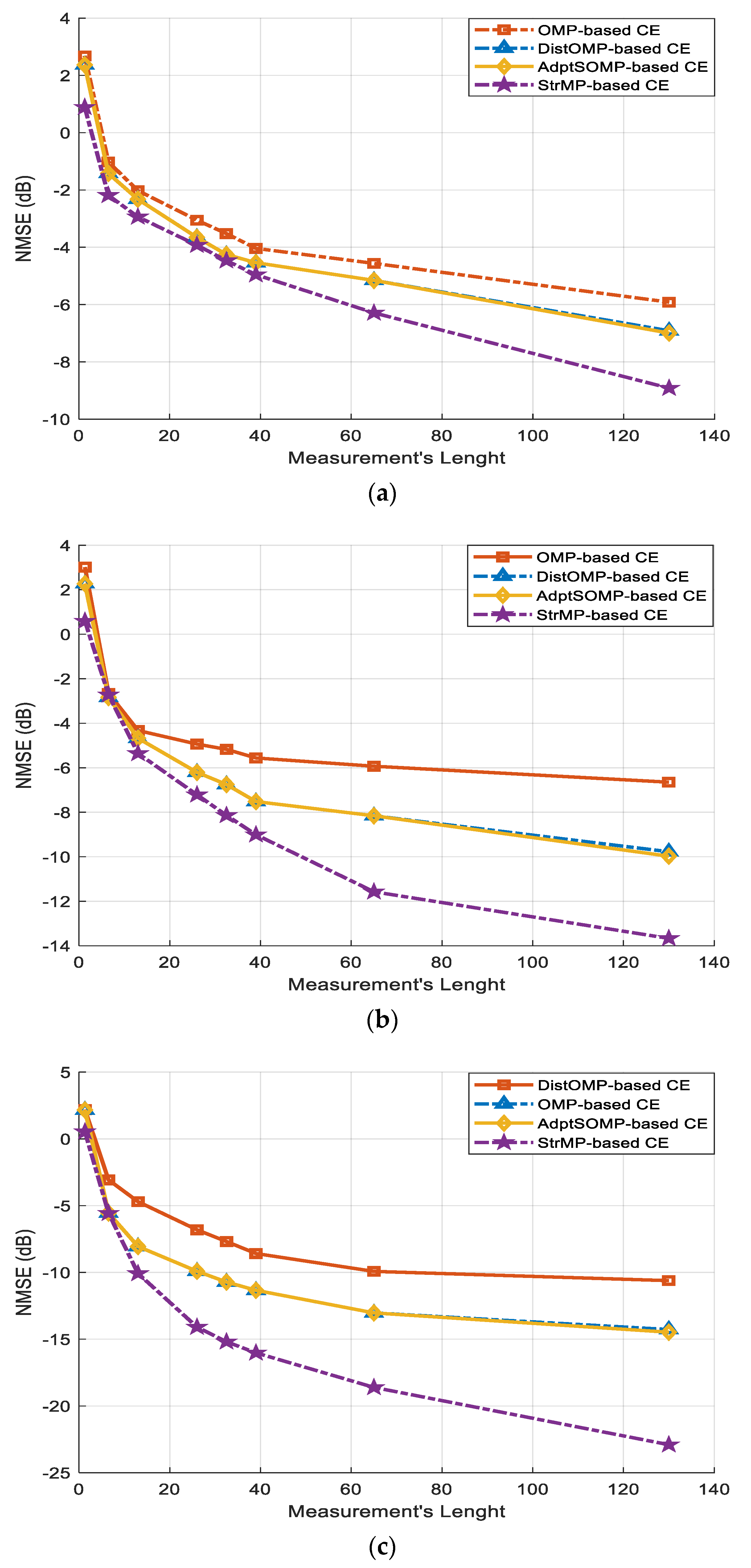
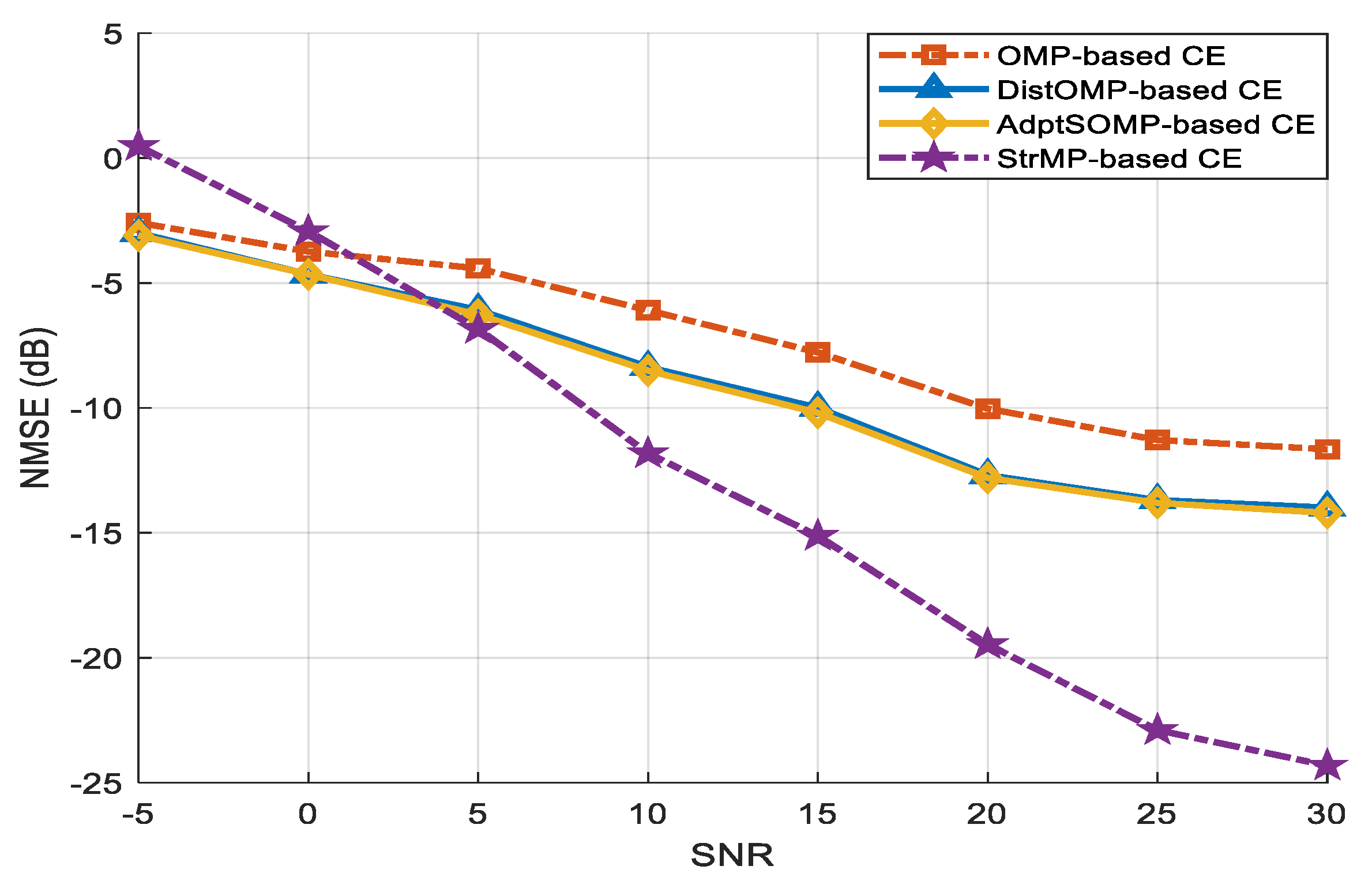
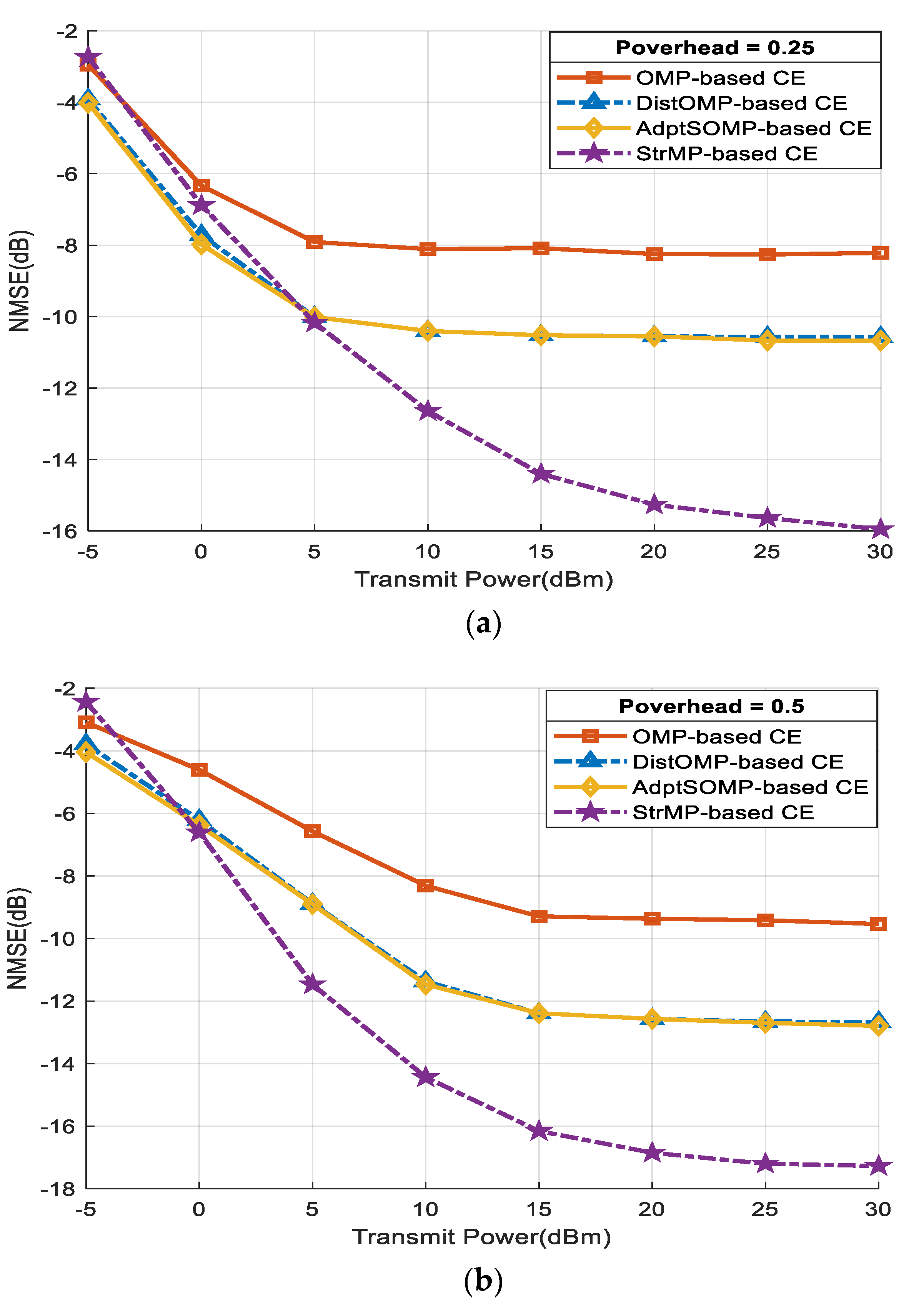

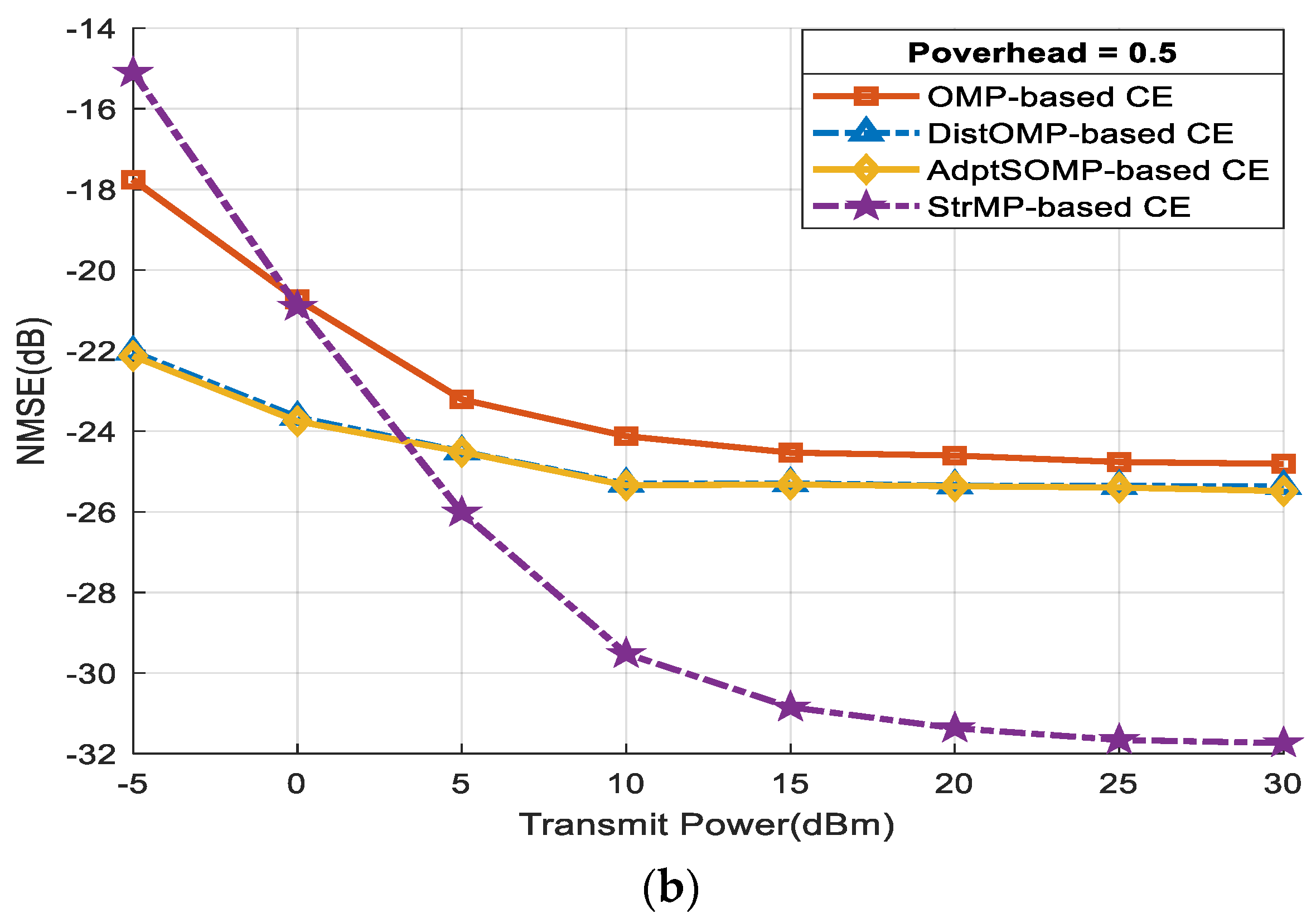
| Channel Estimation Scheme | Complexity Cost’s Order | Numerical-Based Results |
|---|---|---|
| OMP | ||
| DOMP | ||
| Proposed AdptSOMP | ||
| Proposed StrMP |
Disclaimer/Publisher’s Note: The statements, opinions and data contained in all publications are solely those of the individual author(s) and contributor(s) and not of MDPI and/or the editor(s). MDPI and/or the editor(s) disclaim responsibility for any injury to people or property resulting from any ideas, methods, instructions or products referred to in the content. |
© 2024 by the authors. Licensee MDPI, Basel, Switzerland. This article is an open access article distributed under the terms and conditions of the Creative Commons Attribution (CC BY) license (https://creativecommons.org/licenses/by/4.0/).
Share and Cite
Oyerinde, O.O.; Flizikowski, A.; Marciniak, T.; Zelenchuk, D.; Ngatched, T.M.N. Compressive Sensing-Based Channel Estimation for Uplink and Downlink Reconfigurable Intelligent Surface-Aided Millimeter Wave Massive MIMO Systems. Electronics 2024, 13, 2909. https://doi.org/10.3390/electronics13152909
Oyerinde OO, Flizikowski A, Marciniak T, Zelenchuk D, Ngatched TMN. Compressive Sensing-Based Channel Estimation for Uplink and Downlink Reconfigurable Intelligent Surface-Aided Millimeter Wave Massive MIMO Systems. Electronics. 2024; 13(15):2909. https://doi.org/10.3390/electronics13152909
Chicago/Turabian StyleOyerinde, Olutayo Oyeyemi, Adam Flizikowski, Tomasz Marciniak, Dmitry Zelenchuk, and Telex Magloire Nkouatchah Ngatched. 2024. "Compressive Sensing-Based Channel Estimation for Uplink and Downlink Reconfigurable Intelligent Surface-Aided Millimeter Wave Massive MIMO Systems" Electronics 13, no. 15: 2909. https://doi.org/10.3390/electronics13152909





